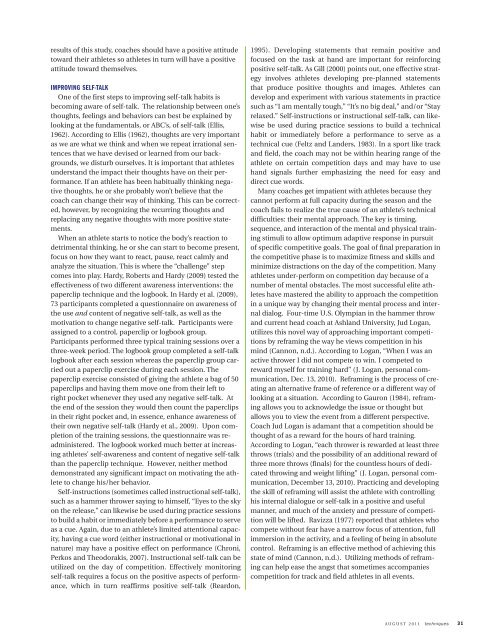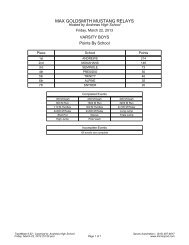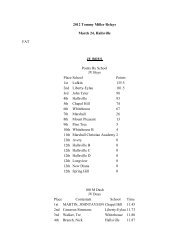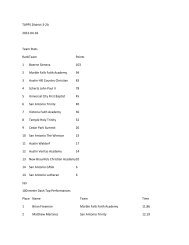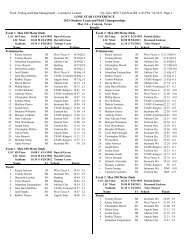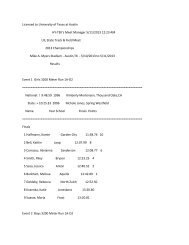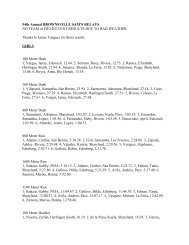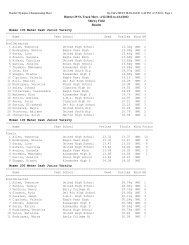1. PAGES 1-35 - Texas Track & Field Coaches Association
1. PAGES 1-35 - Texas Track & Field Coaches Association
1. PAGES 1-35 - Texas Track & Field Coaches Association
You also want an ePaper? Increase the reach of your titles
YUMPU automatically turns print PDFs into web optimized ePapers that Google loves.
esults of this study, coaches should have a positive attitude<br />
toward their athletes so athletes in turn will have a positive<br />
attitude toward themselves.<br />
IMPROVING SELF-TALK<br />
One of the first steps to improving self-talk habits is<br />
becoming aware of self-talk. The relationship between one’s<br />
thoughts, feelings and behaviors can best be explained by<br />
looking at the fundamentals, or ABC’s, of self-talk (Ellis,<br />
1962). According to Ellis (1962), thoughts are very important<br />
as we are what we think and when we repeat irrational sentences<br />
that we have devised or learned from our backgrounds,<br />
we disturb ourselves. It is important that athletes<br />
understand the impact their thoughts have on their performance.<br />
If an athlete has been habitually thinking negative<br />
thoughts, he or she probably won’t believe that the<br />
coach can change their way of thinking. This can be corrected,<br />
however, by recognizing the recurring thoughts and<br />
replacing any negative thoughts with more positive statements.<br />
When an athlete starts to notice the body’s reaction to<br />
detrimental thinking, he or she can start to become present,<br />
focus on how they want to react, pause, react calmly and<br />
analyze the situation. This is where the “challenge” step<br />
comes into play. Hardy, Roberts and Hardy (2009) tested the<br />
effectiveness of two different awareness interventions: the<br />
paperclip technique and the logbook. In Hardy et al. (2009),<br />
73 participants completed a questionnaire on awareness of<br />
the use and content of negative self-talk, as well as the<br />
motivation to change negative self-talk. Participants were<br />
assigned to a control, paperclip or logbook group.<br />
Participants performed three typical training sessions over a<br />
three-week period. The logbook group completed a self-talk<br />
logbook after each session whereas the paperclip group carried<br />
out a paperclip exercise during each session. The<br />
paperclip exercise consisted of giving the athlete a bag of 50<br />
paperclips and having them move one from their left to<br />
right pocket whenever they used any negative self-talk. At<br />
the end of the session they would then count the paperclips<br />
in their right pocket and, in essence, enhance awareness of<br />
their own negative self-talk (Hardy et al., 2009). Upon completion<br />
of the training sessions, the questionnaire was readministered.<br />
The logbook worked much better at increasing<br />
athletes’ self-awareness and content of negative self-talk<br />
than the paperclip technique. However, neither method<br />
demonstrated any significant impact on motivating the athlete<br />
to change his/her behavior.<br />
Self-instructions (sometimes called instructional self-talk),<br />
such as a hammer thrower saying to himself, “Eyes to the sky<br />
on the release,” can likewise be used during practice sessions<br />
to build a habit or immediately before a performance to serve<br />
as a cue. Again, due to an athlete’s limited attentional capacity,<br />
having a cue word (either instructional or motivational in<br />
nature) may have a positive effect on performance (Chroni,<br />
Perkos and Theodorakis, 2007). Instructional self-talk can be<br />
utilized on the day of competition. Effectively monitoring<br />
self-talk requires a focus on the positive aspects of performance,<br />
which in turn reaffirms positive self-talk (Reardon,<br />
1995). Developing statements that remain positive and<br />
focused on the task at hand are important for reinforcing<br />
positive self-talk. As Gill (2000) points out, one effective strategy<br />
involves athletes developing pre-planned statements<br />
that produce positive thoughts and images. Athletes can<br />
develop and experiment with various statements in practice<br />
such as “I am mentally tough,” “It’s no big deal,” and/or “Stay<br />
relaxed.” Self-instructions or instructional self-talk, can likewise<br />
be used during practice sessions to build a technical<br />
habit or immediately before a performance to serve as a<br />
technical cue (Feltz and Landers, 1983). In a sport like track<br />
and field, the coach may not be within hearing range of the<br />
athlete on certain competition days and may have to use<br />
hand signals further emphasizing the need for easy and<br />
direct cue words.<br />
Many coaches get impatient with athletes because they<br />
cannot perform at full capacity during the season and the<br />
coach fails to realize the true cause of an athlete’s technical<br />
difficulties: their mental approach. The key is timing,<br />
sequence, and interaction of the mental and physical training<br />
stimuli to allow optimum adaptive response in pursuit<br />
of specific competitive goals. The goal of final preparation in<br />
the competitive phase is to maximize fitness and skills and<br />
minimize distractions on the day of the competition. Many<br />
athletes under-perform on competition day because of a<br />
number of mental obstacles. The most successful elite athletes<br />
have mastered the ability to approach the competition<br />
in a unique way by changing their mental process and internal<br />
dialog. Four-time U.S. Olympian in the hammer throw<br />
and current head coach at Ashland University, Jud Logan,<br />
utilizes this novel way of approaching important competitions<br />
by reframing the way he views competition in his<br />
mind (Cannon, n.d.). According to Logan, “When I was an<br />
active thrower I did not compete to win. I competed to<br />
reward myself for training hard” (J. Logan, personal communication,<br />
Dec. 13, 2010). Reframing is the process of creating<br />
an alternative frame of reference or a different way of<br />
looking at a situation. According to Gauron (1984), reframing<br />
allows you to acknowledge the issue or thought but<br />
allows you to view the event from a different perspective.<br />
Coach Jud Logan is adamant that a competition should be<br />
thought of as a reward for the hours of hard training.<br />
According to Logan, “each thrower is rewarded at least three<br />
throws (trials) and the possibility of an additional reward of<br />
three more throws (finals) for the countless hours of dedicated<br />
throwing and weight lifting” (J. Logan, personal communication,<br />
December 13, 2010). Practicing and developing<br />
the skill of reframing will assist the athlete with controlling<br />
his internal dialogue or self-talk in a positive and useful<br />
manner, and much of the anxiety and pressure of competition<br />
will be lifted. Ravizza (1977) reported that athletes who<br />
compete without fear have a narrow focus of attention, full<br />
immersion in the activity, and a feeling of being in absolute<br />
control. Reframing is an effective method of achieving this<br />
state of mind (Cannon, n.d.). Utilizing methods of reframing<br />
can help ease the angst that sometimes accompanies<br />
competition for track and field athletes in all events.<br />
AUGUST 2011 techniques 31


